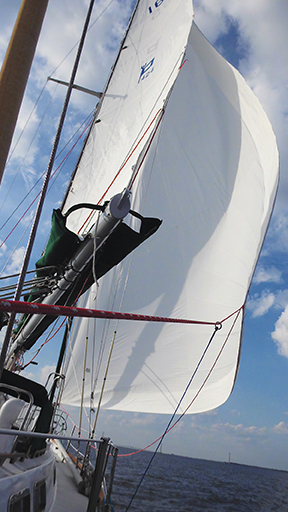How upgrading our sails and sail handling systems means we get to spend more time actually sailing (published June 2014)
As we finish the complete restoration of our 1981 Pearson 424 ketch, Regina Oceani, one of the last major considerations was a new suit of sails. Nowadays it seems that folks are too often just shopping for price and send their sail dimensions off to a China-based website for bids. But if there is one thing I have learned through this four-year project, it is that well-seasoned advice is invaluable, and that sort of advice does not come from a web server.
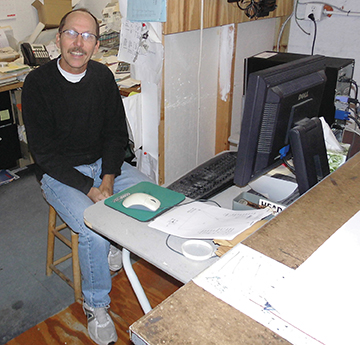
Now that we are based in Melbourne, Florida, and considering our old sails were made by Mack Sails, I reached out to Colin and Travis of Mack Sails, which is just down the road in Stuart. Travis is known for talking with all customers ordering sails from their loft. He first asked about what Jill and I have planned for our boat and I said that we would really like to be well equipped for light wind sailing in the tropics. We have an unused storm jib and trysail that we will keep. Our asymmetrical spinnaker in a sock with an ATN Tacker is fine, but is a lot of hokey pokey to deal with. For extra color, our mizzen staysail is fun, but you can’t tack without taking it down. And the sail tracks on our masts, now with new paint, are even tighter than before, so raising the sails and dousing them can be a chore. With this orientation, Travis made some recommendations I would likely have never considered and certainly would never have received from a website.
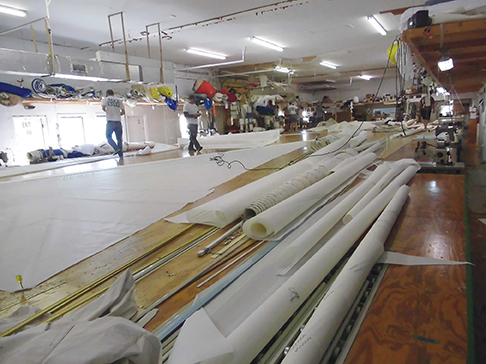
“For starters, let’s get rid of the slides on the foot of your main and mizzen and go loose-footed. This way you can loosen the outhaul downwind and easily put a lot more belly in the sail and flatten it out for upwind sailing.” He continued, “Have you considered a code zero?” I replied that we were not racers. “Yes, this sail comes from working the racing rules to create a large lightweight reaching sail on a continuous line furler. But it uses a Dyneema luff line so you can take it down and store it in a bag. You will love it on your boat! And the mizzen will balance it very well.” A quote arrived that evening and was one I could easily live with.
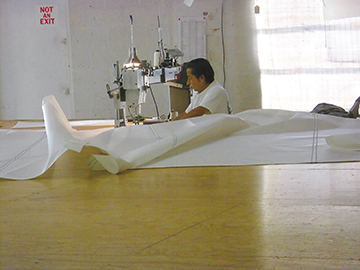
VANQUISHING THE FRICTION
From time to time I have seen sails doused very quickly on cruising boats and had assumed it was due to very expensive auxiliary tracks and ball bearing slides and batten cars. On closer inspection and probing I learned that many had a Tides Track system. As I tend to do, I just picked up the phone and called the manufacturer, Tides Marine in Deerfield Beach, Florida, and spoke with Jeff Strong. Jeff has a history of solving marine problems for himself and friends and then manufacturing products for the rest of us, which started with the SureSeal shaft seals that he has continued to improve over the years.
He shared how he and a machinist friend had come up with an ultra-high density polyethylene track that slides into any existing sail track. “This is a special blend of UV-resistant plastic that we have extruded just for us. We then run it through a milling machine we designed for the purpose that matches the tongue of the track to one of hundreds of possible combinations of width, depth and shape (round or rectangular) that mast makers have come up with over the years. Into the plastic track go custom designed stainless slides, batten slides and head cars.”
I got to study this system up close and it is about as close to friction free as you can get without magnets or magic. Jeff sent me a track measuring kit containing five plastic disks with tabs in various sizes and shapes to measure the thickness, depth and width of our sail tack.
MEASURING UP
Shortly thereafter, the big Seven Seas Cruising Association (SSCA) Gam came to Melbourne and Colin Mack came up to exhibit his wares. He spent a long lunch hour with me aboard our boat. Keep in mind I had just paid a “rigger” to go over my work before we splashed her. Colin is no average rigger; he has been doing this since he was a teenager. Approaching the boat he cocked his head and said, “Oh my, that’s not right.” The clevis pin of the head stay under the furler was not inserted correctly, not caught by the earlier paid “rigger.” Moving back to the main stays, he noted that the lower stay turnbuckles had not been available for over 25 years. “Those were last made in 1980-something—they really need to be replaced. But all your other hardware is top drawer.” He pointed out a number of other things on the rig that could easily be adjusted to improve the ease of handling the sails—some things that were just basically wrong for the last 30 plus years—and explained what hardware I would need at the bow sprit for the code zero furler.
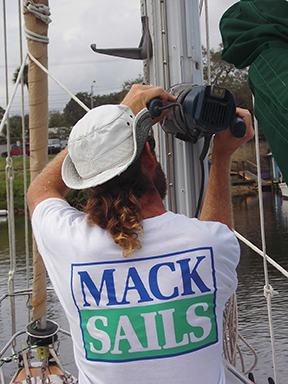
Completely humbled by his knowledge, I took copious notes and I asked Colin about going with a Tides Track. “There is nothing better you could do to make it easy to get the sails up in the morning and to drop them, even off the wind.”
I thought, no more, “Just a little more into the wind Honey, now hold that while I pull, and pull to get the sail down.”
“But we need the measuring disks…”, Colin said.
Fortunately, I had them in my pocket ready to go. The big surprise of the Tides Track is the very reasonable price, especially compared to the ball-bearing type systems. You just pay a price per foot of track and all the necessary slide hardware ships to the sail maker—no ordering and pricing four of car “A,” three of slide “B,” etc.
Our sail order was in line behind dozens of others, but about five weeks later we were able to schedule the installation. After a few more weeks delay due to business travel, Richard the rigger showed up at our dock with his magic van of tools and rigging.
INSTALL TIME
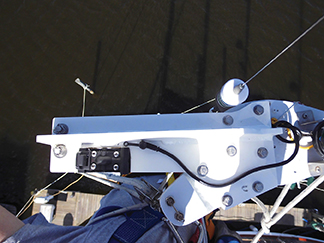
First up was installing the Tides Track on the main and mizzen mast. I had thought about just letting the mizzen go with the original track but was convinced I would not hesitate to use the mizzen more if I had the new track.
To install the Tides Track, the gate of the existing track must be cut longer. Richard laid this out, marked it, and then patiently cut it with a handheld router. Gutsy I thought, but he clearly had it under control. The track comes in a giant pizza box about four feet across. As it is wound up in a coil at the factory, cable ties are progressively added. This makes unrolling the track easy, cutting the cables ties one by one, as a halyard is used to pull the new track up into the groove of the old track using a fitting provided for the purpose. A separate small piece of track is provided to test the grove, all the way to the top of the mast and back down again before unrolling the “real” track. Richard told me that he has never had to send one back for re-milling.
The main and mizzen went up in a flash. Rather than using a headboard car, Colin and Travis recommend the first slide be right below the sail’s headboard. This provides a smoother operation of the sail and assures no off-angle torque on a head car as the halyard pulls it in towards the top of the mast.
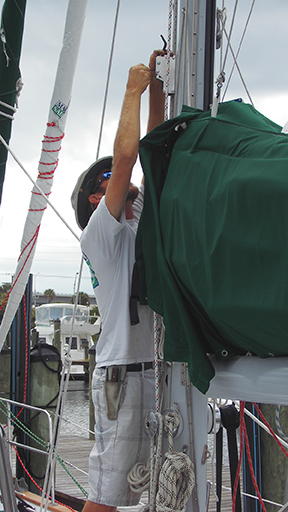
Unfortunately, our new turnbuckles were backordered but the rig was not going to fall down anytime soon. And the UV outer cover material for the code zero was also backordered so Richard would have to come back in a few days to finish up the job. But I was not going to wait. In the morning Jill and I took the Queen out to show off her new sails and my oh my, I never thought this boat could point so high.
After the code zero was installed we had very high winds and a few more distractions, such as the Miami Boat Show, before we really got to test the code zero. In Miami I met up again with Colin and Travis right after attending a BWS-sponsored storm sailing seminar with John Kretschmer. With John, we discussed heaving to with a ketch rig and bringing the storm jib closer to the main mast with a baby stay, so I asked Travis what he thought about that idea.
“Now that you have the code zero furling hardware, it is easy to snap different sails on to it. Let’s put a baby stay tang on your mast and a heavy folding padeye on deck tied into the anchor locker bulkhead. We’ll replace the luff of your storm jib so when you prep for a storm, take down your code zero and put up the storm jib on the furler at the baby stay.” Brilliant! We even discussed re-cutting our asymmetric spinnaker for use on the furler for true running in light winds, but I decided to wait a little for that.
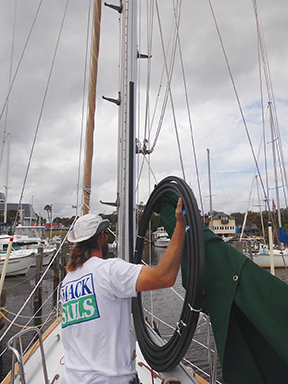
VISITING STUART
On the way to Miami, we stopped in at the Mack Sails loft just as they were opening in the morning. A hoard of riggers came through the doors to get their assignments for the day and pick up the sails and necessary rigging.
I got to meet Kevin, who lays out all the sail material for cutting using a nesting program to conserve material. He espoused his love for building quality sails and explained and showed just how the 8.62-ounce Challenge High Aspect Premium Dacron used on our main and mizzen and the 7.77-ounce Challenge Marblehead Premium is so much tighter woven than lesser materials.
“It’s the only cloth woven with Fiber 104 High Tenacity yarns in both directions (the warp and fill). There is more yarn and less resin fill compared to other cloth. You will really appreciate this several years down the line when your Mack Sails still look like new. Sails made of cheaper materials rely on resin to give the cloth stability and as the resin breaks down so does the sail shape. Travis will not make a sail with lesser materials and even though this material costs more, it is not worth the cost savings to build an inferior product. Your genoa is miter cut and this design holds its shape better over time than a standard cross cut genoa. It’s more labor intensive to make, but it gives you a sail that will stay flat when reefed and last 10 to 15 years with good shape.”
ZERO DAY ON THE OCEAN
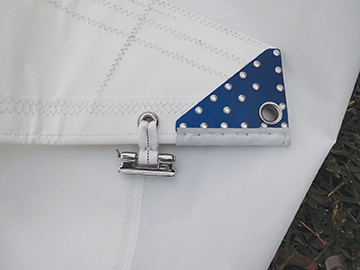
Our real test of the code zero came in March as we sailed north from the Florida Keys out of Miami before sunrise. A slowly building light wind off the bow put us on a close reach starting at six knots of true wind and bringing us into Lake Worth that afternoon in about 12 knots true. It was hard to believe but we made six plus knots through the water in a six-knot breeze on a close reach with the code zero, main and mizzen. Our new Garhauer traveler with both lines fed to one side, combined with the new Garhauer rigid boom vang, both using their performance clutches, made it a cinch to twist the main and get every square foot pulling for us. Letting go of the helm, we were perfectly balanced and hardly needed Barry our autopilot (more on Barry in the next installment).
Without a doubt, the code zero was the right “next” sail to own. Coming into Lake Worth, we dropped our sails well off the wind, just letting the boom out a bit to line up the lazy jacks. And the main sail dropped so fast into its bag with the Tides Track you could miss it if you looked away for a second or two. Jill now says, “Thank you Tides Track” every time the sails go up or down.
BACK TO STUART
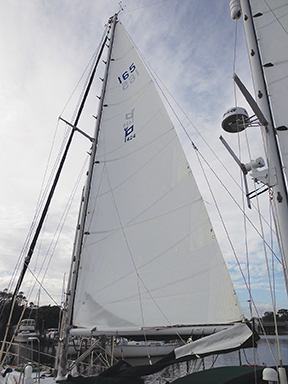
On our way north, we stopped in Stuart, this time by boat, and side tied for a few hours at Apex Marine up the St. Lucie River. There were so many riggers in Mack Sails shirts there that you could swear the place was owned by Mack. They have extended their services to all sorts of rigging and installations including electronics and working on trawlers. Richard showed up to install the baby stay tang and halyard and to deliver the storm jib.
With uncanny attention to detail, Richard carefully planned out the placement of the two new Garhauer clutches on the main mast for the code zero and baby stay halyards and spliced an eye in one end and a reeving eye in the other so a messenger line could be easily pulled if the halyard had to come down. The Spectra code zero halyard can also serve as an emergency stay considering its strength and position.
PUT THE SAILS UP
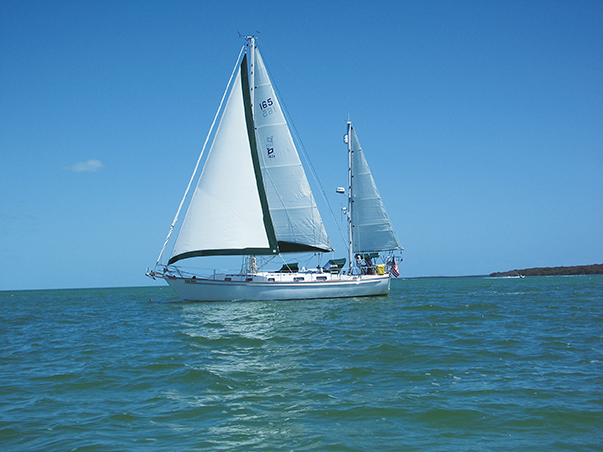 Jill and I are now enjoying Regina Oceani like never before. The new sails draw so well; the Tides Track makes them so easy to raise and lower; the code zero gives us new reaching performance that we have never experienced before; and even those Spectra halyards are nicer to handle. Instead of asking me why I am putting up the sails so soon, Jill asks more often why we haven’t put the sails up yet.
Jill and I are now enjoying Regina Oceani like never before. The new sails draw so well; the Tides Track makes them so easy to raise and lower; the code zero gives us new reaching performance that we have never experienced before; and even those Spectra halyards are nicer to handle. Instead of asking me why I am putting up the sails so soon, Jill asks more often why we haven’t put the sails up yet.
BWS is following Pete and Jill Dubler’s refit and restoration of their Pearson 424 from a corn field in Colorado to the waters of Florida. With their children now through college, their dream of cruising far and wide on a sturdy, seaworthy and reliable boat is becoming a reality.















